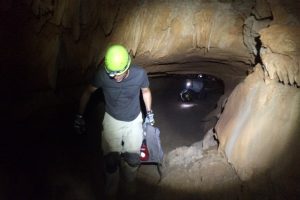
The National Science Foundation just announced that Cornell College will receive grant money that will enable Cornell geologist Rhawn Denniston to continue his studies on past climate research. The grant will also provide support for student involvement in the research.
Denniston, professor of geology and chair of environmental studies, is lead investigator on the research project. The grant money will go to four institutions. Among them, Cornell College will receive $104,085 of the three-year grant, which is worth a total of $358,417.
Funding will not only pay for the research, but it will include support for several Cornell College students who will work closely with Denniston in caves in the Australian tropics and in laboratories in Iowa and New Mexico. A student will also spend time at Woods Hole Oceanographic Institution in Massachusetts contributing to climate modeling work.
Denniston’s studies are already underway. Research by other scientists reveals that about 600 years ago, many parts of Southeast Asia were impacted by a decades-long drought.
Denniston and his colleagues have used stalagmites from a cave in the central Australian tropics to reconstruct changes in the amount of monsoon rain that fell over time. They do this by measuring two types of oxygen atoms (the isotopes oxygen-16 and oxygen-18) found in the stalagmites. They use isotopes of uranium to date the stalagmites.
“A tiny amount of uranium is trapped within the formations, and by measuring the amounts of uranium and the material it radioactively decays into, we can precisely tell how old different layers of the stalagmites are. The stalagmites I’ve worked on so far span the last 3,000 years. This new grant involves working on samples that span 3,000 to 9,000 years ago,” Denniston said.
The grant will provide funding to develop a stalagmite record of fluctuations in Australian monsoon rainfall reaching back to the time of the earliest civilizations.
Studying the changes related to monsoon rainfall is a big step toward understanding the nature and origins of climate change. While numerous studies have documented droughts and wet periods across the northern hemisphere tropics, what is less well known is how the monsoon rains changed at the same time across the southern tropics in Australia.
The grant, titled “Collaborative Research: Reconstructing Holocene Dynamics of the Indo-Pacific Tropical Rain Belt Using Australian Stalagmites and Coupled Climate Models,” involves working with experts spanning a wide array of specialties. Geochemical analyses will be performed in labs at Iowa State University and the University of New Mexico, as well as Cornell College’s Department of Chemistry. Climate models will be run at Woods Hole Oceanographic Institution in Massachusetts. Finally, the fieldwork will be accomplished with help from Australian cavers and scientists. Cornell students will participate in all aspects of this work.
“Our work so far has yielded two surprises,” Denniston said. “First, it is surprising that short-term events like the ones from 600 years ago impacted Australia. Second, it was largely accepted that various factors pushed the Indo-Pacific tropical rain belt, the band of monsoon rainfall that stretches from China to Australia, north or south as a coherent system, meaning that dry periods in China would most likely be correlated with wet periods in Australia. Instead, our data appear to show that the rain belt expanded and contracted like an accordion, rather than moving north and south. Both sides got wet and dry together, at least over the last 3,000 years.”
The official start date of this grant is June 1, 2016. It will extend out for three years. Denniston will start engaging students in this work in the fall of the 2016/2017 school year.
Note: The above post is reprinted from materials provided by Cornell College.










